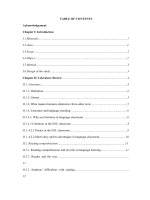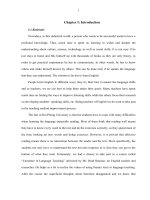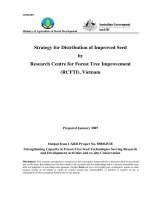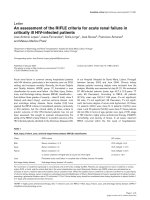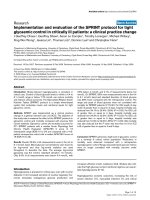The distribution strategy of OTC (over the counter) products for unites pharma international in Vietnam market
Bạn đang xem bản rút gọn của tài liệu. Xem và tải ngay bản đầy đủ của tài liệu tại đây (1.76 MB, 81 trang )
CAPSTONE PROJECT REPORT
THE DISTRIBUTION STRATEGY
OF OTC (OVER THE COUNTER)
PRODUCTS FOR UNITED
PHARMA INTERNATIONAL IN
VIETNAM MARKET
Group No.: 9
TRAN HUU TAI
TRANTHI PHAN ANH
PHAM VAN HIEN
HO SI MINH TUAN
TRUONG DUC HANH
CLASS: GaMBA01.C0110
Ho Chi Minh City, 2011
2011
GLOBAL ADVANCED MBA PROGRAM (GaMBA01.C0110)
Group No.: 9
C0110.MBA-GRIGGS-GROUP 9 –STRATEGY MANAGEMENT
-1-
ACKNOWLEDGEMENTS
Firstly, we would like to thanks the University of Griggs-National University
of Hanoi for providing us with this MBA program. Our group also send our great
thanks to all teacher ,specially Dr. Le Van Bay for instructing group to conduct the
thesis, to Prof. Dr. Nguyen Van Dang and Dr. Nguyen Tan Binh for providing the
group, and the C0110 class with valuable lessons, to Mr. Vu Thai Ha, on behalf of
National University of Hanoi - Griggs University in the south - Vietnam for
sharing, contributing and co-organizing studying program which provides us with
helpful knowledge in the subject as well as in the curriculum. We also appreciate all
sharing and contributions of teachers and classmates in the course during this MBA
classes.
Group 9 consists of five members of C0110 course with the thesis of The
Master of Business Administration, University of Griggs studied by our group.
Theory and related data in the thesis was collected by ourselves at the
company of UPI and reference from sources such as textbooks at the University of
Griggs, textbooks and other reference materials in Vietnamese and English as well
as from magazines, internet The facts collected from the market research of BMI,
AC Nielsen,IMS with useful and practical information
From the source of these documents and based on the approved outline, we
have completed this thesis. The solution for distribution strategy of UPI Company
was made on the basis of theories learned and the experience of each members of
the group. Also through this thesis, the team members have accumulated some
valuable experience for the establishment of a practical strategy for a company.
HCMC-VIETNAM, JULY 2011
Group 9 - GaMBA-C0110
C0110.MBA-GRIGGS-GROUP 9 –STRATEGY MANAGEMENT
-2-
TABLE OF CONTENTS
ACKNOWLEDGEMENTS 1
TABLE OF CONTENTS 2
LIST OF ABBREVIATION 5
LIST OF TABLE 7
Reason to choose topic 10
Practical significance 10
Scope of research 11
Research Methodology 11
CHAPTER I. LITERATURE REVIEW 12
1.1. Overview of strategic management 12
1.1.1. The concept of strategy and strategic management 12
1.1.2. The role of strategic management 12
1.2. Classification of strategic management 13
1.2.1. Group of combined strategies 13
1.2.2. Group of developing strategies 14
1.2.3. Group of expansion strategies 14
1.2.4. Group of other strategies 14
1.3. Distribution strategy 14
1.3.1. The Distribution channel Types 14
1.3.2. Distribution as a principle of marketing 15
1.3.3. Distributors and dealers 17
1.3.4. Process of transportation and distribution of pharmaceuticals 17
1.4. Some tools have been used in the strategic plan 19
1.4.1. The external factors evaluation matrix (EFE) 19
1.4.2. The competitive profile matrix (CPM) 20
C0110.MBA-GRIGGS-GROUP 9 –STRATEGY MANAGEMENT
-3-
1.4.3. The internal factors evaluation matrix (IFE) 20
1.4.4. The SWOT matrix 21
1.4.5. The major strategy matrix 22
CHAPTER 2. INTRODUTION AND ANALYSIS CURRENT STATUS ABOUT PRODUCTION
AND DISTRIBUTION OF UNITED PHARMA 23
2.1 Introduction about United Pharma 23
2.1.1 The formation and development process of United Pharma International. 23
2.1.2 The structure of organization and personel 24
2.1.3 Business sector of UPI: 25
2.2 Analysis current status about production and distribution of united pharma 25
2.2.1 Models and business organization 25
2.2.2 General business results of OTC products at UPI 25
Please see the result in table 5, 6 and table 7 25
2.2.3 Activities and business results of the distribution system 25
Distribution result by Channel and Territory 29
2.2.4 Overall assessment of the current business status of UPI Vietnam 32
CHAPTER 3. THE DISTRIBUTION STRATEGY FOR UNITED PHARMA INTERNATIONAL
34
3.1 Vission, missions and developing orientation of the company 34
3.1.1 Vissions 34
3.1.2 Missions 34
3.1.3 The developing orientation of the company 34
3.2 The objective of distribution strategy 35
3.3 Distribution strategy for UPI and implementation 35
3.4 The analysis of internal and external environment 36
3.4.1 The analysis of internal environment 36
3.4.1.1 The management 36
3.4.1.2 The finance 36
C0110.MBA-GRIGGS-GROUP 9 –STRATEGY MANAGEMENT
-4-
3.4.1.3 The production 37
3.4.1.4 Human resource 37
3.4.1.5 Marketing and market research 38
3.4.1.6 Technology research 38
3.4.2 The analysis of external environment 38
3.4.2.1 Political environment, legal, economic 39
3.4.2.2 The social – culture environment 43
3.4.2.3 The technical environment 43
3.4.2.4 Customers 43
3.4.2.5 Competitors 44
3.4.2.6 The supply of raw materials 48
3.4.2.7 The human resource supply 50
3.5 Building a strategic matrix 50
3.5.1 The external factors evaluation matrix (EFE) 50
3.5.2 The internal factors evaluation matrix (IFE) 51
3.5.3 The competitive profile matrix (CPM) 52
3.5.4 The SWOT matrix 53
3.5.5 The major strategic matrix 57
3.6 The supporting to implement the distribution strategy 59
3.6.1 Human resources supporting and Implementation 59
3.6.2 Finance supporting and Implementation 63
3.6.3 Production supporting and Implementation 63
3.6.4 Marketing, market reseach supporting and implementation 64
3.7 Conclusions 66
C0110.MBA-GRIGGS-GROUP 9 –STRATEGY MANAGEMENT
-5-
LIST OF ABBREVIATION
UPI : United Pharma International
AFTA: Asean Free Trade Area
ASEAN: Association of Southeast Asian Nations
BCG: Boston Consulting Group matrix
DAV:Drug Administration of Vietnam
DMC: Domesco Medical Companies
DPM: Department of Vietnam Pharmaceutical Management
DPDM: Distribution Planning & Development Manager
EFE: The External Factors Evaluation matrix
EU: European Union
ETC :Ethical
FDI: Foreign Direct Investment
GLP: Good Laboratory Practice
GMP: Good Manufacturing Practice
GSP: Good Storage Practice
IFE: The internal factors evaluation matrix
NAFTA: North American Free Trade Agreement
NSM: National Sales Manager
OHSAS: Occupational health and safety
OTC: Over the counter
PICS: Pharmaceutical Inspection Co-operation Partnership Scheme
QSPM: Quantitative strategic planning matrix
C0110.MBA-GRIGGS-GROUP 9 –STRATEGY MANAGEMENT
-6-
ROM: Regional Operation Manager
TDS: Trade Development Supervisor
TDR: Trade Development Rep
TMKM: Trade Maketing Manager
WTO: World Trade Organization
WHO : The World Health Organization
BMI : Business Monitor Internationa Company(UK)
IMS : is the leading provider of information services for the healthcare industry,
covering markets in 100+ countries around the world.
VSIP: VietNam Singapore Industry Park
YTD: Year To Date
BO: Buying outlet
RG: Regular buyer
RPS: Retailer Product Standard
KRA: Key Result Area
C0110.MBA-GRIGGS-GROUP 9 –STRATEGY MANAGEMENT
-7-
LIST OF TABLE
Table 1. The external factors evaluation matrix 20
Table 2. The competitive profile matrix 20
Table 3. The matrix for evaluation of internal factors 21
Table 4. The SWOT 21
Table 5. The Category in distribution result YTD July 2011 28
Table 6. YTD June 2011 Sales By Channel 30
Table 7. Result in distribution by territory by VND 31
Table 8. The long-term economic forecast in Vietnam 41
Table 9. The index of medications business in the Asia – Paciffic area in the quarter
I - 2011 42
Table 10. The external factors evaluation matrix (EFE) 51
Table 11. The internal factors evaluation matrix (IFE) 52
Table 12. The competitive profile matrix (CPM) 53
Table 13. The SWOT matrix 54
Table 14. The major strategy matrix 58
Table 15. New Organization of Sales & Distribution apply for distribution strategy
60
Table 16. The property and funds of the business in 2010 63
Table 17. Analysis Report of operations 63
Table 18. PAMS Apply For Distribution Strategy 67
Table 19. Organization Chart In Sales & Distribution Department( Before revise
Distribution strategy) 70
Table 20. Products are distributed by Gannon Group 71
Table 21. Products are distributed by Zuellig Group 72
C0110.MBA-GRIGGS-GROUP 9 –STRATEGY MANAGEMENT
-8-
Table 22. The index of demographic of Vietnam, 2005-2030 73
Table 23. The Statistical Table rural / urban Vietnam, 2005-2030 73
Table 24. The statistics of vital Vietnam, 2005-2030 73
Table 25. 17 corporations leading in otc vietnam market 75
C0110.MBA-GRIGGS-GROUP 9 –STRATEGY MANAGEMENT
-9-
LIST OF FIGURE
Figure 1. Distribution channel 16
Figure 2. Marketing channel types 16
Figure 3. The structure of organization 24
Figure 4. Distribution channel 27
Figure 5. The export of pharmaceutical raw materials in Vietnam 49
Figure 6. Types of imported materials 50
Figure 7. New Distribution Systems of UPI 65
Figure 8.The all leading company sharing data (Source IMS) 74
Figure 9.2 Year trend of top 5 corporations 76
Figure 10.Top 20 Products 77
Figure 11. Top 17 corporation Growth 78
Figure 12. Top cities Analysis (Value by Billion VND) 79
C0110.MBA-GRIGGS-GROUP 9 –STRATEGY MANAGEMENT
-10-
TOPIC:
THE DISTRIBUTION STRATEGY OF OTC (OVER THE COUNTER)
PRODUCTS FOR UNITED PHARMA INTERNATIONAL IN VIETNAM
MARKET
Reason to choose topic
As we know health is a very special and important thing to everyone,
whenever thinking of health we often think of a healthy lifestyle, healthy living
environment without pollution, when a society is developing, the industry,
agriculture, services of Vietnam in particular and world in general also changes and
develop to a certain extent. Besides, the pressure of life and work is affecting the
health of each person. Regarding health issue, we chose the topic of the pharmacy
OTC market in Vietnam to partly contribute our opinions to the health of the public.
Pharmaceuticals market in Vietnam is worth about USD 27.361 billion (U.S.
$ 1.54 billion) in 2009. In the forecast period up to 2014, BMI predicted
pharmaceutical sales will hit USD 56.931 billion (U.S. $ 3.04 billion), the market
forecast will reach USD 107.395 billion (U.S. $ 6.61 billion) in 2019. Source:BMI
- Vietnam is a market for 87 million people so it is very potential for
development for the pharmaceutical industry
- Vietnam is still remnants of war, landmines
- Weather is often natural disasters, stormy, pollution
- Pharmaceutical industry is still young
- The corporations was into the Vietnam market and competition is fierce
- The goal of high growth from companies
- Currently the company is distributing 7000 drug stores in nationwide
but in the nationwide having 20000 drug store
Because of the above causes, we need to set up proper distribution channels
to develop far area and increase new outlets
Practical significance
C0110.MBA-GRIGGS-GROUP 9 –STRATEGY MANAGEMENT
-11-
Analyzing and assessing the macro-economic development of Vietnam, the
government policy on pharmaceutical manufacturing business and competitive
environment in Vietnam and other competitors to identify opportunities and threats.
Assessing fairly comprehensively the real situation of the distribution
channel of the United Pharma, which is belonged to the Unilap Group, the inner
resources, from which we determine the strengths and weaknesses.
From the opportunities, challenges and strengths, weaknesses and we
propose a distribution strategy appropriate with the state of the United pharma
companies, which will implement effectively the business strategies outlined
Scope of research
Major business lines of the company is producing and trading of
pharmaceutical OTC on the basis of comparison with competitors.
Research Methodology
The topic focuses on researching, analyzing primary and secondary
information and data collected as follow:
• Secondary information was collected at UPI and several other
companies who are direct competitors. In addition, the data are
collected through the mass media, through the statistics, the Ministry
of Industry, survey report from market research firm.
• Primary Information: The construction of the matrix of strategic
choices is made by the method of experts to identify the
environmental factors inside, outside influencing production and
business activities of the enterprise, identifying the importance of the
elements.
C0110.MBA-GRIGGS-GROUP 9 –STRATEGY MANAGEMENT
-12-
CHAPTER I. LITERATURE REVIEW
1.1. Overview of strategic management
1.1.1. The concept of strategy and strategic management
What is Strategy?
According to Fred R. David, "Strategy are the means to reach the long-term
goals.Business strategy may include the geographical development, diversification
of activities, possession, product development, market penetration, cutting
spending, liquidation and joint ventures "
What is Strategic Management?
According to Fred R. David, "Strategic Management is an art and science of
stablishment, implementation and evaluation of decisions related functionality
which allows an organization to achieve goals"
1.1.2. The role of strategic management
Facing the above opportunities and challenges, strategic management today
has special roles:
- Strategic management help achieve the goals of the organization. The role
of goals is very important. If not to reach any goals, there is no need for
management.
- Strategic Management is broadly interested in the subjects concerned. To
survive and develop enterprises must satisfy and meet the needs of organizations
and individuals involved such as customers, suppliers, employees, government
The needs and interests of these subject concerned can be different, even
contradictory. The departments of enterprise tend only to satisfy the needs of the
organizations and individuals related to their departments without consider
harmonizing the common interests of all subject concerned.
C0110.MBA-GRIGGS-GROUP 9 –STRATEGY MANAGEMENT
-13-
- Strategic management associates the short-term development in the context
of long-term. The long-term strategic goals is an important basis for planning and
short-term goals. Through short-term target and plan it achieves long-term strategic
objectives. In the context of rapid environmental change and uncertainty, the
adaptive capacity of the enterprise is important, but it is only effective when based
on a long-term orientation. Each individual departments of the business just pay
attention to short-term goal of its department. This can be detrimental to the long-
term strategic objectives of the business. Thus the strategic management will direct
the efforts and resource of the enterprise at reaching this goal.
- Strategic Management takes interest in both effectiveness and
performance. The effectiveness is to solve the right jobs, and efficiency is to solve
the job in the right way. The managers in the department tend to improve
performance, but this does not always lead to the achievement of business
objectives and can cause a huge waste.
1.2. Classification of strategic management
1.2.1. Group of combined strategies
Combination with customers: related to the increase in ownership or
control for distributors or retailers. One effective way to implement this
combined strategy is franchise, businesses can grow rapidly by franchising
because cost and opportunities spread for many individuals.
Combination with suppliers: related to the search for ownership or control
of the company's suppliers. This strategy is particularly appropriate when
the existing supplier of the company can not be trusted, too expensive or
impossible to satisfy the requirements of company
Horizontal combination: involves finding the ownership or control of the
competitors. The merger, acquisition and control domination among
competitors allow increasing effectiveness about range and increasing the
exchange of resources and capacity
C0110.MBA-GRIGGS-GROUP 9 –STRATEGY MANAGEMENT
-14-
1.2.2. Group of developing strategies
Market penetration: seeking increased market share for existing products
and services in existing markets through greater marketing efforts.
Market development: to offer available products and services to new
areas.
Product development: increasing sales by improving or modifying
available products or services. Product development requires research
costs and big growth.
1.2.3. Group of expansion strategies
Diversity activities oncentrically: addition for new products or services are
related to each other.
Diversifying the operation horizontally: addition for the new products or
services, not related to each other for existing customers.
Diversification activities in mixed type: addition for the products or
services without contact with each other.
1.2.4. Group of other strategies
Joint venture: two or more companies to sponsor a independant company
for the purpose of cooperation.
Collapsing operation: Reinforced through cost and assets cutting to save
sales and profits are declining.
Cutting down operations: Selling off the branches or part of company.
Liquidation: sell all the assets separately, with tangible value.
Synthesis: the pursuit of two or more strategies simultaneously.
1.3. Distribution strategy
1.3.1. The Distribution channel Types
It is also called marketing channel or trade channel, the critical thing that
makes products available at the point of sales.
C0110.MBA-GRIGGS-GROUP 9 –STRATEGY MANAGEMENT
-15-
According to Kotler, most producers use third parties or intermediaries to
bring their products to the market. They try to forge a distribution channel – a set of
interdependent organizations involved in the process of making a product or service
available for use or consumption by the consumer or business user. The channel of
distribution is therefore all those organizations through which a product must pass
between its points of production and consumption. Why do producers give some of
the selling job to intermediaries? After all, doing so means giving up some control
over how and to whom the products are sold. The use of intermediaries results from
their greater efficiency in marketing goods available to target markets. Through
their contacts, experiences, specialization and scale of operation, intermediaries‟
uaually offter the firm more than it can achieve on its own.
1.3.2. Distribution as a principle of marketing
“Distribution is a set of interdepent organization involved in the process of
making a product or service available for use or consumption by cunsomer or
industrial”
It is involved with the strategies and logisticts of moving goods from the
producer to the customer.As opprosed to pricing,ad and orther short-term
activities,distribution channel cannot be modifiel or altogether changed in a matter
of hour or even days.Distribution is more than just a set of links between source
destination it required specific transactions,like buying and selling,inventory
control,channel promotion ,contacts ,matching ,negotiation ,physical tranportation
,financial resources and other assets. People interact at several levels of channel
distribution models can either sell directly or indirectly to customer.Typically in the
later case,a variable number of intermediaries (agents,distributor, wholesalers,
retailers etc) Can be interfaced between the producer and the customer.The natural
of the market place,as well as the product and the environmental competition
generally defines this model.
C0110.MBA-GRIGGS-GROUP 9 –STRATEGY MANAGEMENT
-16-
Figure 1. Distribution channel
Source :P.Kotler,”Principle of marketing” 2nd edition, pp 895
Malcom Mc Donald,”Marketing Plans” 4th Edition, pp 386
Channel organization can be structure either conventional or structure in a
vertical marketing system “see illustration below “.In the former,each organization
is dependent and tends to seek its own advantage and profit,even to detrmin of the
whole system.where in the former they tend to work as a unifield system that can be
controlled by one its member and enforced by sets of contracts and agreements.
Figure 2. Marketing channel types
Conventional Marketing channel Vertical Marketing system
Retailer
Manufacture
Whosaler
Retailer
Consumer
Consumer
Manufacture
Whosaler
Retailer
Whosaler
Originating Producer
Agent
Whosaler
Retailer
Retailer
Post office
Customer
C0110.MBA-GRIGGS-GROUP 9 –STRATEGY MANAGEMENT
-17-
1.3.3. Distributors and dealers
Wholesaling
According to Kotler (1996), there are two types of wholesalers as follow:
- Full service wholesalers: Wholesalers that provide a full set of services
such as carrying stock, using a sales force, offering credit, making
deliveries and providing management assistance. They are either
wholesaler merchants who sell mostly to retailers or industrial
distributors who sell mainly to another.
- Limited service wholesalers: Perform a limited number of functions and
offer fewer services to their suppliers and customers. There are several
types of limited-service wholesalers such a Cash and Carry, truck
wholesalers, drop shippers, rack jobbers, producers‟ co-operatives, and
mail order wholesalers
Retailing
Retail stores come in all shapes and sizes, and new retail types keep
emerging. Such as:
- Sale service retailers, limited service retailers, cash-and-carry retailers.
- Specialty store, department store, variety store, convenient store,
superstore, discount store.
- Supermarkets, hypermarkets.
1.3.4. Process of transportation and distribution of pharmaceuticals
Physical distribution management is a critical factor in the successful
marketing of all products. Underlying effective and efficient physical distribution
management is the physical distribution concept. According to Stern and Ansary
(1989), the concept takes a cost-service orientation that is aimed at minimizing the
C0110.MBA-GRIGGS-GROUP 9 –STRATEGY MANAGEMENT
-18-
distribution costs for delivering a given level of customer service through a
coordinated physical distribution network.
The system must balance the cost of providing desired customer service
levels against the cost of lost sales from not delivering those levels of service.
A critical aspect of this “balancing act” is selecting warehousing, inventory,
and transportation policies that ensure the desired customer service levels are met.
Logistics or supply-chain management is the widely used for the
management of the flow of goods and services and related information from the
point of origin to the point consumption. The aim is to maximize the performance of
the entire distribution system.
Order processing
The logistic process starts with the firm getting an order from a customer. An
order can be submitted in many ways-by mail or telephone, through sales people, or
via computer and electronic data interchange. Once received, the order must be
processed quickly and accurately.
Both the company and its customers benefit when the order-processing steps
are carried out efficiently. Ideally, sales people send in their orders daily, often
using online computer.
Choosing transportation model
A recent study (kotler) states that, in practice, firms may rely on a
combination of transportation methods which would best enable them to meet
logistic objectives: low cost and effectiveness.
Warehousing
There are two types of warehouse facilities available to channel members:
Private warehouses: offer greater flexibility, in design to meet special
storage and handling needs, greater control over the warehouse facility and
C0110.MBA-GRIGGS-GROUP 9 –STRATEGY MANAGEMENT
-19-
its operations, more effective information feedback, and lower cost per unit
since it does not have to recover advertising and selling cost.
Public warehouse: required no fixed investment by the firm; offer low cost
under certain circumstances, as when it is necessary to store seasonal
inventories.
Distribution centers are designed to move goods rather just store them.
1.4. Some tools have been used in the strategic plan
At present, in the process of strategic planning, managers often use some
technical tools to support decision making such as:
The external factors evaluation matrix (EFE)
The competitive profile matrix (CPM)
The internal factors evaluation matrix (IFE)
The SWOT matrix
The SPACE matrix
The consulting group matrix BOSTON (BCG)
The major strategy matrix
The quantitative strategic planning matrix (QSPM)
Due to time limitations made the subject so it mainly focused on EFE Matrix
and IFE in the first research, CPM and SWOT matrix for combined to create
strategies for UPI, the main matrix for the decision to select appropriate strategies
for UPI.
1.4.1. The external factors evaluation matrix (EFE)
The matrix for evaluation of external factors allows strategic experts to
summarize and evaluate information of economy, society, culture, demographic,
geographic, political, government, laws, technology and competition
C0110.MBA-GRIGGS-GROUP 9 –STRATEGY MANAGEMENT
-20-
Table 1. The external factors evaluation matrix
Major factors of
outside environment
Critical level (From
0.0 to 1.0 for each
factor)
Classification
(From 1 to 4 for
each important
factors)
Important
points
List of the external
factors
Total
The higher score shows that the company respond to external factors better
1.4.2. The competitive profile matrix (CPM)
The competitive matrix can help the company to identify rivals, as well as
their strengths and weaknesses in order to help company having suitable business
strategy.
Table 2. The competitive profile matrix
1.4.3. The internal factors evaluation matrix (IFE)
This matrix summarizes and reviews the important strengths and weaknesses
affecting to parts of business function, it affects the production and business
activities of enterprises
The important point of each variables help determining total important pint
Sucessful
factors
The
importance
level
Example of competitors
Competitor 1
Competitor 2
Classification
Important
points
Classification
Important
points
Classification
Important
points
List of
factors
Total
important
point
C0110.MBA-GRIGGS-GROUP 9 –STRATEGY MANAGEMENT
-21-
to the company; the highest point is 4, the lowest point is 1, and the average point is
2.5.
The important point is lower than 2.5 will show that the company is weak in
internal factors; higher than 2.5 will shot that the company is strong in internal
factors.
Table 3. The matrix for evaluation of internal factors
Major internal factors
The
importance
level
Classification
Important
point
List of internal factors
Total
1.4.4. The SWOT matrix
The SWOT matrix is an important combination tool to help developping 04
types of strategies as follows:
- Strengths – Opportunities strategy (SO)
- Strengths – Threats strategy (ST)
- Strengths – Weaknesses strategy (SW)
- Weaknesses – Threats strategy (WT)
We have the SWOT matrix table as follows:
Table 4. The SWOT
Opportunities – O
Threats - T
Strengths - S
SO strategies
Using strengths to take advantage of
opportunities
ST strategies
Using strengths to avoid
threats
Weaknesses - W
WO strategies
Overcoming weaknesses by taking
advantage of opportunities
WT strategies
Minimizing weaknesses and
avoiding threats
C0110.MBA-GRIGGS-GROUP 9 –STRATEGY MANAGEMENT
-22-
1.4.5. The major strategy matrix
The major strategy matrix is a popular tool for the formation of strategic
which can be chosen. All organizations and parts of the company can be located in
one of the four quadrant of the square strategy of the Grand Strategic Matrix in
Table 1.6. This Matrix is based on the following two aspects to evaluate: the
competitive position and growth of the market. The appropriate strategy for the
organization listed in order of attraction in every corner of the square matrix.
Week
competitive
position
Quadrant II
1. Market/ Product
development.
2. Market penetration
3. Horizontal
integration
4. Divestiture/
Liquidation
Quadrant I
1. Market/ Product
development.
2. Market penetration
3. Forward/ Horizontal/
Backward integration
4. Related diversification
Strong
competitive
position
Quadrant III
1. Retrenchment
2. Unrelated
diversification
3. Horizontal/ Related
diversification
4. Divestiture/
Liquidation
Quadrant IV
1. Unrelated
diversification
2. Horizontal/ Related
diversification
3. Joint ventures
C0110.MBA-GRIGGS-GROUP 9 –STRATEGY MANAGEMENT
-23-
CHAPTER 2. INTRODUTION AND ANALYSIS CURRENT STATUS
ABOUT PRODUCTION AND DISTRIBUTION OF UNITED PHARMA
2.1 Introduction about United Pharma
2.1.1 The formation and development process of United Pharma
International.
UPI Vietnam is a member of the Unilab Group, a consortium which
specializing in health care in Asia, have many offices operating in 10 countries in
the Asia Pacific, producing about 350 popular pharmaceutical brands with high
quality products and specialized health care to consumers. These products are
manufactured in 12 factories equipped with modern in the Philippines, Indonesia,
China, Thailand and Vietnam.
Strong consumer brand was granted in 2005, Vietnam award for high quality
goods received in the same year. This demonstrates that the stability of the product
is bearing the mark of the company over the years. This award is granted by Saigon
Magazine
Parent company United Laboratories Inc., started the business from a small
drug store in the downtown area was devastated by the war in Manila, Philippines in
1945. And 14 years later, a small drug store became the leading pharmaceutical
company in the Philippines.
Over many years, Unilab has established several production facilities and
marketing as multinational companies and research organizations in the United
States, Europe, India, China and Japan. Growth leads to more continuous
improvements in manufacturing products and systems, always a leader in modern
technology to meet the changing needs of the market and the challenge of
competition. UPI 's presence in Vietnam began in 1990, is a 100 % foreign-owned
factory building from 1997, when multinational companies are still a representative
office. UPI is one of the first factory certified WHO - GMP - GLP - GSP, ISO and
C0110.MBA-GRIGGS-GROUP 9 –STRATEGY MANAGEMENT
-24-
OHSAS. Currently, we are to build a new factory in VSIP 2 industrial zones,
designed to meet GMP - PICS to help United Pharma become the plant which is the
global leading quality superiority.
Currently, UniedPharma Head office located E town 2 Building, HCM City,
two sales offices in HCM City and Hanoi, a factory in Binh Chanh Dist.
Address No 16 VSIP II, Street 7, VietNam Singapore industry Park II, Ben
Cat Dist, Binh duong Province ,VietNam
2.1.2 The structure of organization and personel
Figure 3. The structure of organization
The company's employees in departments are participated the training
programs to improve skills of professional every year to ensure the legacy and
professional.
Especially the company uses PAMS system specifically to each department
to evaluate the working results and bonus at the end of year

